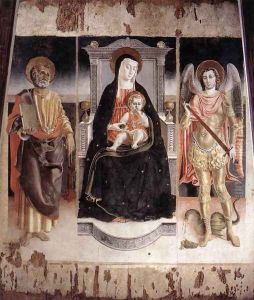Lorenzo Da Viterbo Paintings
Lorenzo da Viterbo, also known as Lorenzo di Pietro or Lorenzo da Viterbo, was an Italian painter active during the Renaissance period. His exact date of birth is not known, but he is believed to have been born around 1446-1450 in Viterbo, a town in central Italy. Not much is known about his early life or training, but he is thought to have been influenced by the work of Benozzo Gozzoli and Fra Angelico, among others.
Lorenzo's work is characterized by a blend of the Umbrian and Florentine styles, illustrating the transitional nature of art during his lifetime. He was primarily a fresco painter and is known for his delicate use of color and graceful compositions, which reflect the early Renaissance's exploration of perspective and human anatomy.
One of his most famous works is the 'Madonna and Child Enthroned with Saints', a fresco in the apse of the church of Santa Maria della Verità in Viterbo. This masterpiece is celebrated for its elegance and for the serene expressions of the figures, which exhibit Lorenzo's sensitivity to the spiritual themes of the time.
Lorenzo da Viterbo's artistic career also involved collaboration with other artists, such as Antonio del Massaro da Viterbo, with whom he worked on the Borgia Apartments in the Vatican. His contributions to the Vatican are indicative of the recognition he received during his lifetime.
Although not as widely known as some other Renaissance artists, Lorenzo da Viterbo played a significant role in the art of his region and the period. His works can be found in various churches in Viterbo and in collections that specialize in Italian Renaissance art.
Lorenzo da Viterbo's death is recorded as having occurred in 1503. His legacy continues to be appreciated by art historians and enthusiasts who recognize his contribution to the development of Italian Renaissance painting, particularly within the context of the lesser-known but culturally rich town of Viterbo.
